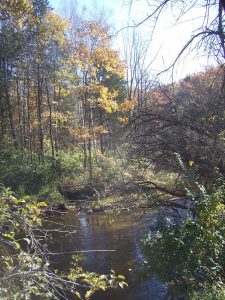Shorelines

Vegetated stream buffers help keep Portage Creek healthy
The shorelines in our watershed consist of riverbanks, stream banks, and lake shores. Any land that is directly adjacent to these waterbodies is a shoreline.
Undisturbed native vegetation bordering our streams, rivers, and wetlands acts as a vital stream buffer. The vegetation slows storm runoff while filtering nutrients, pollutants, and sediment before they enter the water.
The trees, shrubs, plants, and grasses in these riparian* buffer zones provide a natural and gradual transition from terrestrial to aquatic environments. These buffer areas are also critical for wildlife habitat. By storing water during periods of high water flow, they protect lakes and rivers from pollutants.
* Riparian: the environment found on the banks of a river or stream.
How communities can protect shorelines
The easiest way to protect our shorelines is to keep the natural vegetation in our buffer zones. However, people live, work, and play along our shores, and many of the Huron’s stream and river corridors have been stripped of natural vegetation and replaced with turfgrass, seawalls, concrete rubble, boulders, or other artificial barriers that sever the critical connection between land and water. The eventual result is bank erosion and an accessible path for pollutants and sediments to flow directly into our waterways.
In addition to leaving the vegetation intact, there are many ways to protect our buffers:
- Local governments can incorporate shoreline buffers into local zoning and ordinances
- Shoreline property owners can learn about and abide by Michigan’s laws regarding designated Natural Rivers District areas in the Huron River corridor (more information here)
- Communities and property owners can plant deep rooted native plants along shorelines that have been cleared
What HRWC is doing to protect shorelines
HRWC protects buffer zones through educating communities and making recommendations on how to treat lands along rivers, lakes and streams. In particular:
- We prepared a summary and recommendations report based on our studies of buffer zones in the watershed: Report on Stream Buffers in the Huron River Watershed.
- HRWC also created a Model Ordinance for Stream Buffers It has text for local communities to use when drafting their zoning and ordinances.
- We assist local communities with the process for developing their buffer zone protection ordinances.
- HRWC educates property owners on the importance of buffer zones and how they can protect them.
What you can do to protect shorelines
- Use rain gardens, native plants rain barrels and porous surfaces
- Plant and maintain a shoreline buffer of trees, shrubs, taller grasses and wildflowers
- Allow downed trees, stumps, and logs to remain (fish and water bugs like to live around and under them)
- Lawn care: mow high (3 inches+), mulch your clippings, and pick up pet waste. Use phosphorus-free fertilizers
- Have your septic system regularly inspected and pump out your tank every 3-5 years
- Clean, drain, and dry boats and trailers before moving them so you do not transport aquatic invasive species
- Bonus tips: Geese love turfgrass. By planting native plants along your shoreline, you will deter geese.



